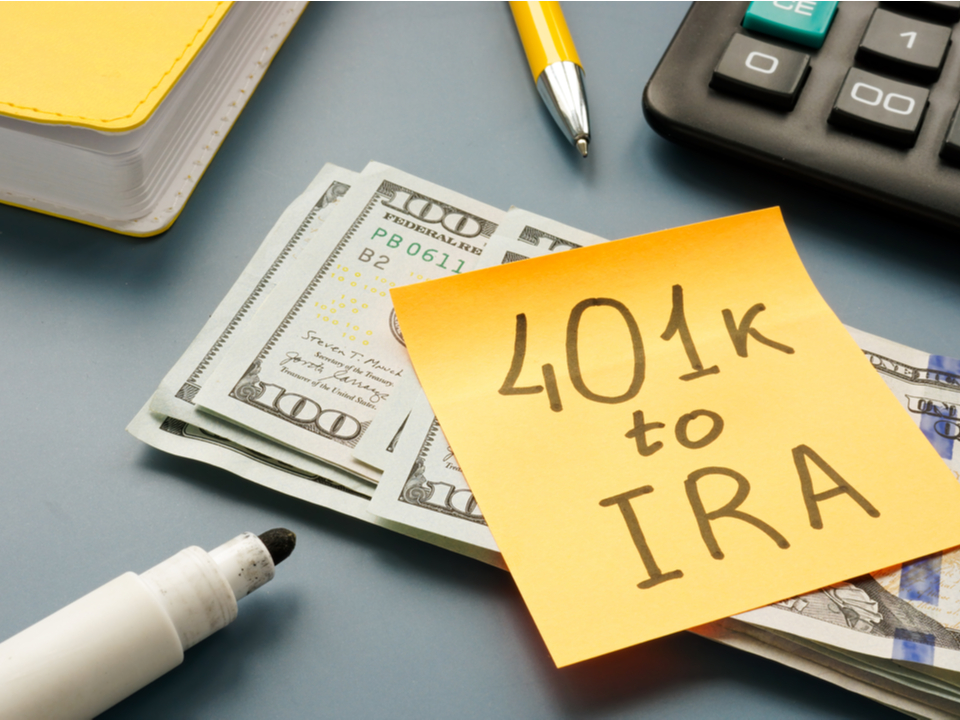Diversifying your retirement portfolio with gold is a smart way to stabilize your investments, hedge against inflation, and reap the benefits of different types of assets. Are you looking to convert your 401(k) into gold? You can roll over your 401(k) into a gold IRA without penalty as long as you follow the right steps.
In this guide, you’ll learn everything you need to know about how to move a 401(k) into gold without penalty.
What It Means To Roll Over a 401(k) Into Gold
If you have an employer-sponsored 401(k), it likely invests in various mutual funds, such as index funds, real estate funds, or bond funds. You may not have much control over where the money in your account goes, and you’re subject to the volatility of the mutual funds it invests in.
You can “roll over” all or a portion of your 401(k) into a gold-backed IRA to gain more control over your retirement investments and diversify your portfolio. This type of self-directed IRA means you can choose from a range of non-traditional assets to invest in.
When performed correctly, a 401(k) rollover transfers your funds from your 401(k) into a gold IRA without fees or penalties. You can begin reaping the benefits of your new gold investment within days.
A gold IRA rollover differs from a transfer, which moves funds from one IRA account into another.
Traditional IRAs vs. Self-Directed Gold IRAs

Rolling over your 401(k) into a self-directed IRA instead of a traditional IRA poses many benefits. With a traditional IRA, your IRA custodian — typically a bank or brokerage firm — limits your investment options to specific, approved securities. You don’t have much control over where your retirement money goes or the volatility of your account.
Meanwhile, a self-directed IRA gives you complete control over all investment decisions. You also have the opportunity to invest in alternative assets that are off-limits for traditional IRAs.
Aside from gold, you can use a self-directed IRA to invest in the following:
- Silver
- Real estate
- Cryptocurrency
- Private equity
- Promissory notes
Apart from these differences, self-directed IRAs follow all the same IRS rules and have the same tax advantages as traditional IRAs.
Benefits of Converting 401(k) Into a Gold IRA
Moving your 401(k) into a gold IRA poses several benefits for your retirement investing:
- Diversify your portfolio: Having some of your retirement money invested in gold and other money in different assets effectively diversifies your portfolio, reducing its volatility and protecting your retirement savings.
- Execute greater control: With a self-directed IRA, you have complete control over where you invest your retirement funds. You don’t have to choose from a limited selection of mutual funds or sacrifice control to an account broker.
- Potentially gain higher returns: Historically, gold has been an asset that experiences long-term growth and economic stability. You have the potential to increase your returns with a gold investment compared to traditional mutual funds.
- Experience tax benefits: Rolling over a 401(k) into a gold IRA allows you to defer taxes on your retirement funds until you withdraw them.
With a gold IRA, you gain the benefits of investing in gold alongside the benefits of an IRA.
Eligibility for a Gold IRA Rollover
Before exploring the process of how to move a 401(k) into gold without penalty, ensure your 401(k) is eligible for this rollover.
If you have a 401(k) with a former employer, you can likely roll it over into a self-directed IRA. A traditional 401(k) will roll over into a self-directed IRA, while a Roth 401(k) will roll over into a self-directed Roth IRA.
You can also roll over a 403(b) account or ESOP account from a former employer or an active traditional IRA or Roth IRA into a self-directed IRA.
If you have an active 401(k) with a current employer, you probably won’t be able to roll it over into a self-directed IRA. The only exception is if your plan allows for an in-service withdrawal and you are at retirement age. It won’t hurt to reach out to your 401(k) broker to determine whether you are eligible for a gold IRA rollover.
How To Move a 401(k) Into a Gold IRA Without Penalty

The process of moving a 401(k) into a gold IRA is relatively straightforward. When working with a gold IRA company, you’ll be partnered with an account manager who completes much of the process for you.
Here are the steps for converting a 401(k) into a gold IRA without penalty:
1. Choose the Right Gold IRA Company
Your first step is to choose a gold IRA company to assist you with the transfer and manage your new self-directed IRA. You’ll have control over the types of gold you hold in the account, but your gold IRA company will take care of storing the gold for you and either act as the custodian or match you with a custodian to oversee the investment.
The company you choose can make or break your investment process. Look for a company with excellent customer service, a wide range of gold products to choose from, and positive customer reviews. It won’t hurt to speak with two or three companies on the phone before narrowing your choices.
Talk to each gold company you’re interested in about their rollover process. Some companies complete more of the process for you than others. If you’re looking for a hassle-free 401(k)-to-gold rollover process, you’ll do well to pass the responsibility off to a professional.
Also, remember to browse the company’s gold inventory to ensure that all of your desired products are available. The IRS only allows you to invest in specific gold products and precious metals, but choosing a company with a wide selection of IRA-eligible products can give you greater control over the investment.
If you want to place other precious metals, such as silver, platinum, or palladium, in your account, confirm that those products are available through your chosen gold IRA company as well.
2. Open a Self-Directed Gold IRA Account
Once you’ve chosen your preferred company, you will follow its steps to open a self-directed IRA account, which you will use to invest in gold products. Most companies match you with an account specialist or manager who walks you through the entire process.
You’ll generally need to fill out an application on the gold IRA company’s website, including information about your location, finances, age, and retirement goals. You’ll also need to provide identification. This process is regulated by the IRS.
Different gold IRA companies have different minimum requirements for opening a new self-directed IRA. The minimum is typically at least $10,000, but some companies require at least $50,000 to open an account. Ensure your 401(k) has the necessary funds to qualify for a self-directed gold IRA before opening a new account.
3. Initiate the Gold IRA Rollover Process

The next step in how to move a 401(k) into gold without penalty is funding your account. You will fund your account by transferring funds from your 401(k) into it through a rollover.
You will initiate the rollover by contacting your 401(k) custodian. Some gold IRA companies will do this step for you.
Then, you’ll need to fill out a rollover form detailing where you would like to transfer the funds from your 401(k) account. You’ll need to determine whether you’re completing a direct or indirect rollover, which we explain below.
Direct Rollover
If you’re trying to complete a gold IRA rollover from a 401(k) without penalties, you’ll likely want to complete a direct rollover instead of an indirect rollover.
A direct rollover directly transfers the funds from your 401(k) to your new gold IRA. You won’t withdraw any of the funds from your 401(k) into your bank account; instead, they will directly transfer into your new account. This process eliminates the risk of tax penalties and generally involves less paperwork than an indirect rollover.
Indirect Rollover
In an indirect gold IRA rollover, you would withdraw the funds from your 401(k) and then deposit them into your new gold IRA. The upside of this type of rollover is that you gain short-term access to your 401(k) funds, meaning you could spend them (though you would face tax penalties for doing so).
You’ll need to deposit your 401(k) funds into your gold IRA within 60 days. Failing to meet this deadline could lead to tax penalties. You’d need to pay a 10% early withdrawal penalty if you are younger than 59.5 years old.
4. Buy Gold
Once you have successfully transferred the funds into your new gold IRA, you can choose the gold products to purchase through your gold IRA company.
The IRS has specific guidelines for IRA-allowable precious metals. Gold products must meet the minimum requirements:
- Gold must be at least 99.5% pure.
- Gold bars, coins, and rounds must be produced by an accredited refiner, assayer, manufacturer, or national government mint.
- The gold products must have the producer’s mint mark.
- Small bullion bars must be manufactured to the exact weight specifications they are advertised as.
- Proof coins must be in original mint packaging and in excellent condition.
- Non-proof coins must be free from damage.
Thankfully, your gold IRA company has likely already identified gold products that meet these specifications. Some of the more common IRA-eligible gold products offered by gold IRA companies include:
- American Eagle bullion and coins
- Canadian Maple Leaf coins
- Australian Kangaroo coins
- Chinese Panda coins
- U.S. Buffalo bullion coins
Your account manager can provide you with a list of IRA-eligible gold products available through its website. You can also talk to your account manager if you have any questions about a product. While they can’t provide investment advice, they can help you understand the products you’re interested in.
Tax Benefits of a Gold 401(k) Rollover

Rolling over a 401(k) into a gold IRA offers a few tax benefits aside from its other advantages.
When you begin making new contributions to your gold IRA aside from what you transferred from your 401(k), you will make them using pre-tax dollars, reducing your taxable income. When you withdraw your IRA funds at retirement age, you will then owe taxes on them based on your then-current income level. If your income is lower in retirement than it is now, you’ll end up paying less in taxes.
Another tax benefit is that your contributions to a gold IRA may be tax-deductible in the year you make them. Be sure to review the IRS’s guide on IRA deduction limits to learn more about whether you would qualify for a tax deduction.
Finally, when you complete a direct rollover, you don’t need to pay any taxes on the transfer.
Tax Implications and Penalties of Gold IRA Rollovers
Part of learning how to move a 401(k) into gold without penalty is understanding the potential penalties you may face should you approach this process incorrectly. You should also understand the tax implications of a gold IRA rollover, as you will eventually need to pay taxes on your gold investment.
Should you complete an indirect rollover, you risk incurring a 10% early withdrawal penalty if you fail to deposit your funds into your new gold IRA within 60 days. This penalty will only apply if you are not of retirement age, which is 59.5, and is the same penalty you would face for an early withdrawal of a traditional IRA.
When you reach retirement age and begin taking distributions from your gold IRA, you’ll owe taxes on them based on your income at the time. However, because the IRS considers gold a collectible, you may owe the 28% capital gains tax rate on the withdrawal instead. If your normal tax rate is higher than 28%, this capital gains tax rate could result in cheaper taxes on your gold investment.
Potential Risks and Downsides of a Gold IRA

Making a gold investment with 401(k) funds could be a wise investment decision overall, but it also poses a few downsides you should be aware of. No investment is perfect, but understanding the risks and disadvantages of a gold IRA rollover allows you to take measures to avoid penalties.
Potential Risks of a Gold IRA
You need to handle the gold in your self-directed IRA the right way to avoid penalties in your 401(k)-to-gold transfer. For example, you cannot engage in self-dealing or utilize your IRA funds for personal gain. These funds are intended for retirement savings, and using the gold for personal use is illegal under IRS regulations.
As part of this rule, you’ll need to store your gold and other precious metals in a qualified depository rather than taking physical possession of them. Taking possession of any of the products in your self-directed IRA could result in a 15% penalty for the amount of the transaction. If the transaction is incorrect, you may face an additional 100% penalty.
Taking physical possession of the gold in your self-directed IRA is also considered a distribution, which means you’ll need to pay income taxes on the distribution at your current tax rate. You’ll also owe an additional 10% early withdrawal penalty.
Overall, ensure you know how to move a 401(k) into gold without penalty before getting started.
Disadvantages of a Gold IRA To Consider
Keep these disadvantages in mind as you decide whether to complete a gold IRA rollover from a 401(k):
- Higher maintenance fees: Gold IRAs have higher fees than other types of IRAs because of the additional costs of investing in gold. You’ll have to pay to store your gold in a depository and pay administrative and custodial fees to your gold IRA company.
- Illiquidity: Gold is sometimes considered an illiquid asset, as selling large amounts of it can be challenging without offering a discount. When it comes time to cash out your IRA, you’ll need to take the time to find a buyer. Some gold IRA companies will buy back your gold at market value.
- Volatility: Like any investment, gold is volatile. Its value can increase or decrease without warning. Because you have to take distributions from your IRA once you turn 72, you risk needing to withdraw your gold at a time when its value is relatively low.
- Risk of loss: Because gold is a physical asset, there’s always a risk that something will happen to it before you can cash out your gold IRA. You should store your gold in a depository with excellent insurance coverage. However, you may need to pay more for such a depository.
Choosing Gold Investments for a Self-Directed IRA

One of the major benefits of moving a 401(k) into a gold IRA is having complete control over how you invest your retirement funds. You can choose the specific gold products to hold in your gold-backed IRA as long as they meet IRS guidelines.
These are three types of gold products to consider for your self-directed IRA.
Gold Bullion
Gold bullion is the term for physical gold of high purity. It can come in several forms, including bars, ingots, and coins.
A gold product must be at least 99.5% pure to be considered gold bullion. However, you can purchase gold bullion in various weights, ranging from as small as one gram to as large as one kilogram. The standard gold bullion bar is the Good Delivery bar, which weighs 12.4 kg.
The advantage of investing in gold bullion instead of gold coins is that you can typically purchase more ounces of gold for less money than you would for individual coins. If you’re looking to transfer a large sum of money into gold, purchasing a high-weight gold bullion is a simple way to do so.
Gold bullion may also be easier to sell than collectible gold coins, as people who are looking for a simple way to invest in gold are more likely to buy bullion. However, bullion may be harder to sell than non-collectible gold coins, which are smaller and less expensive.
Gold Coins
The IRS allows you to invest in certain collectible gold coins as part of your gold-backed IRA. A few common examples include:
- American Gold Eagle coins
- American Gold Buffalo coins
- Australian Gold Philharmonic coins
- Canadian Gold Maple Leaf coins
- Australian Gold Kangaroo coins
Collectible gold coins have value in their gold content and in their rarity. You may be able to sell a rare gold coin for more than its gold content is worth. However, IRS-approved collectible gold coins typically aren’t very rare.
You can also invest in non-collectible gold coins, also known as “rounds,” as part of your gold IRA. These coins do not hold legal tender and are simply generic rounds with a specific gold content.
Gold ETFs
If you’d rather avoid the fees associated with investing in physical gold but still want to reap the benefits of a gold investment, consider gold exchange-traded funds (ETFs). These funds often invest in physical gold bullion, but you don’t need to be responsible for the gold in them. You can also find ETFs that invest in the stocks of gold companies, allowing you to benefit from the highs and lows of the gold market.
Gold ETFs are more liquid than physical gold, as you can sell your ETFs quickly when you decide to cash out your IRA. You can also track the performance of your gold ETF investments in real-time through online trading platforms.
However, gold ETFs don’t give you that satisfying feeling of knowing you own physical gold.
Storage and Custodian Requirements
![]()
One of the important steps in how to move a 401(k) into gold without penalty is storing your gold in an approved storage facility. Taking physical possession of your gold could lead to a 15% penalty on top of a 10% early withdrawal fee.
You’ll also need to choose an IRS-approved custodian to manage your gold. If the IRS finds out an unapproved broker is managing your IRA, you could face further penalties.
Choosing an IRS-Approved Custodian
Many gold IRA companies also act as custodians, managing your gold investments for you. Others partner with one or two custodians and connect new customers to them after they fund their gold-backed IRAs.
Either way, you should work with a knowledgeable custodian who has overall positive reviews from customers. You also need to ensure that your custodian has been approved by the IRS to provide custodial services.
Selecting Approved Storage Facilities
Instead of storing the gold yourself, you’ll need to select an IRS-approved gold depository to house your gold until you cash out your IRA. Many gold IRA companies have specific storage depositories they work with to store their clients’ gold. You can either choose one of these companies or do your own research to find a better option.
Here are a few qualities to look for in a gold storage depository:
- Security: Gold storage facilities need to have strong security measures in place to prevent theft. They should have 24/7 surveillance and numerous security cameras placed throughout their facilities.
- Insurance: Your depository should also have high coverage insurance for all the precious metals in the facility. No security measures are 100% foolproof, and there’s always a small risk that your gold could be stolen. However, your storage facility should have enough insurance to cover the full value of your precious metals in the rare case they are stolen or destroyed.
- 24/7 access: An added feature to look for in a gold depository is 24/7 access. This would allow you to visit your precious metals at any time. While you can’t take possession of them, being able to check on them could give you peace of mind.
Be sure to review a storage depository’s fees before choosing it. Some depositories charge a flat yearly rate for all customers, while others charge more to store larger amounts of gold.
You can expect to pay anywhere from $100 to $1,000 a year for your storage depository. If you’re trying to save money, look for a facility with lower fees.
Choosing the Right Gold IRA Company for a Gold IRA Rollover
You’ll want to spend ample time researching gold IRA companies to make the best decision for your investment goals. You may be working with a company for several decades until you start taking distributions from your IRA, so choosing one that provides a reliable experience with friendly customer service is a must.
With so many gold IRA companies in business across the U.S., finding the right one can be challenging. Follow these steps to narrow your options:
- Consider your preferred gold products. You’ll want to choose a gold IRA company that sells the type of gold you’re looking to invest in. Browse each company’s product page as the first step in your selection process.
- Make sure the company does 401(k) rollovers: Some companies only assist with IRA transfers, not 401(k) rollovers. Double-check that the companies on your list deal with 401(k)s.
- Read customer reviews: Reading reviews on Google and the Better Business Bureau can help you anticipate what it will be like working with a company. If a company has negative reviews detailing poor customer service interactions, it may not be your best choice.
- Talk to a representative: Speaking with a gold IRA representative from each company on your shortlist can help you get a feel for their customer service style, expertise, and friendliness. If you have a hard time getting ahold of someone or the person you talk to doesn’t seem very knowledgeable, they may not be able to provide the best support for your gold IRA.
- Make your choice: Finally, narrow your options to the company that provides the best customer service during your phone conversation.
If you’re still having trouble choosing a gold IRA company, consider taking the quiz through Learn About Gold. You can get matched with the best gold IRA company for your needs.
Final Thoughts: Should You Roll Over a 401(k) Into a Gold IRA?
If you’re considering investing in gold for retirement, rolling over a 401(k) from a previous employer into a gold IRA could help you achieve your investing goals. Thankfully, the process for moving a 401(k) into gold without penalty is very straightforward. As long as you initiate a direct transfer, you shouldn’t face any fees or taxes for the transfer.
At Learn About Gold, we provide free resources to help you understand the gold investing process and make wise investment decisions that move you closer to your financial goals. Learn more about gold IRAs, or explore our blog for related articles about investing in gold.





